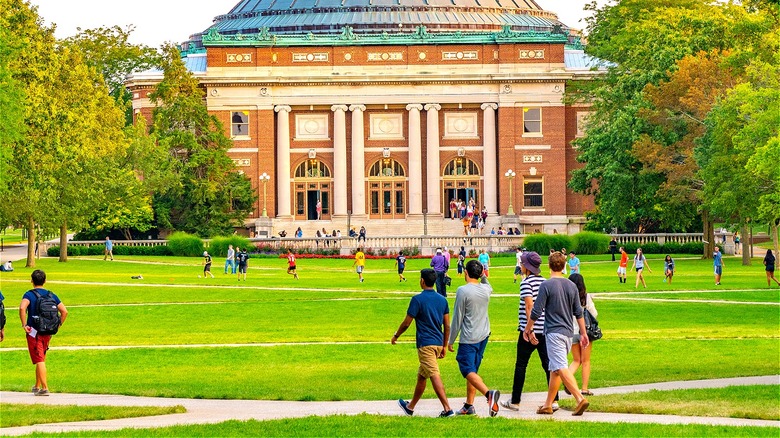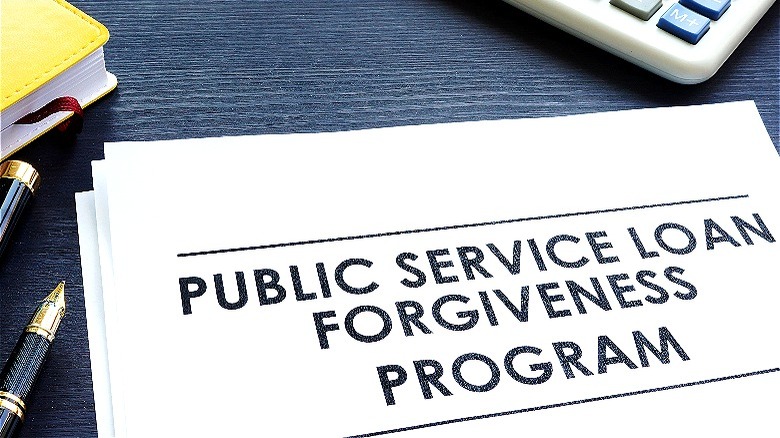Student Loans: What Refinancing Means For Loan Forgiveness
Many Americans were holding their breath that some — or even all — of their outstanding student loan debt might be forgiven thanks to legislation that was introduced by the Biden administration in 2022. However, with President Biden's promise of student loan forgiveness effectively blocked by the Supreme Court, many are instead facing payments they simply can't afford. From high-interest rates to long-term loan agreements, student loans are keeping millions of Americans in debt. As of 2024, 43 million Americans have student loan debt collectively totaling a massive $1.75 trillion, according to the Federal Reserve. This includes federal student loans and private student loans.
While the Biden administration had attempted to forgive student loans in other ways in order to bypass the Supreme Court's initial decision, ultimately, the majority of borrowers faced the return of their student loan payments in September 2023. The resumption of loan payments, combined with inflation, has added an additional financial burden on many people. This might have you wondering about refinancing, especially if you've received offers that could give you a single interest rate (as opposed to differing rates per loan). While it can certainly be tempting to pursue refinancing in order to streamline your loan repayment (or maybe even lower your monthly payment amount), there are some serious considerations you should be aware of before moving forward with debt consolidation or refinancing your student loans. Namely, losing the potential for loan forgiveness in the future.
Student loan forgiveness
For starters, there are a number of ways that a borrower can have their federal student loan debt eventually forgiven. From Public Service Loan Forgiveness (PSLF) to Teacher Loan Forgiveness to the Saving on a Valuable Education (SAVE) plan, student borrowers today have options. Most of these forgiveness options involve the borrower making a certain amount of successful payments toward their student loans. (See how to choose the best student loan repayment plan for you.)
For instance, to qualify for the PSLF program, a borrower must make 120 qualifying monthly payments (or 10 years' worth) while working full-time for a qualifying employer. After doing this, the remaining balance on any Direct Loans the borrower might have is forgiven. Each program has slightly different qualifying requirements, but the end result is that your remaining loan balance is forgiven by the federal government. Note that these forgiveness programs only apply to federal student loans and not private student loans. (Which should you pay off first: federal or private student loans?)
The difference between federal student loans and private ones is at the crux of why refinancing might not necessarily be the best option for you. Speaking with Time, Robert Farrington, CEO of The College Investor, a finance-focused media company, explained, "Private loans are owned by banks and lenders, and the government has no control over the terms and conditions of the loan." This means that if you hold private loans, chances are very small your loan amounts will ever be canceled without being paid in full. Said Farrington, "Programs like loan forgiveness are only available for loans the government owns."
How refinancing changes your loans
If you currently hold federal student loans and hope to qualify for any forgiveness programs in the future, then refinancing your loans is a bad idea. This is because refinancing your federally owned loans will essentially make your loans private (since refinancing is typically done through a bank or lender). This means you'll lose any/all federal loan protections (such as how borrowers received a pause on their loan payments during the COVID pandemic) as well as your ability to participate in repayment options like deferment, forbearance, and income-driven repayment plans like SAVE or PAYE. While banks and lenders offering refinancing options typically promote lower interest rates, it's important to factor in all the other elements of a long-term loan and not over-prioritize student interest rates above your own consumer protections as a borrower.
If you're a borrower who already has private student loans, and are therefore already ineligible for federal student loan programs, then refinancing the loan could potentially be financially worthwhile. Refinancing or consolidating multiple loans into one could not only help you stay organized but also ensure you have a lower interest rate (which could, in turn, lower your monthly payment amount). This can also be an option if you're looking to release a co-signer that might have been attached to your existing student loans. As always, it's important to carefully review any loan terms, keeping a specific eye on the APR terms, and how refinancing might end up extending the length of time of your repayment term. (Here are a few things to keep in mind before consolidating your debt.)


